Solar power, including batteries, and tall structures, like windmills and communication towers, were at the top of the priority list of ordinances to be reviewed and created during a joint meeting between the Patrick County Board of Supervisors and Planning Commission on June 18.
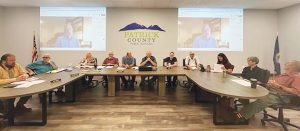
Festival special events, short-term rentals, manufactured homes, derelict homes, and a subdivision ordinance also were among the priorities discussed.
The creation of the ordinances will be handled by the Berkley Group, a local government consulting firm which specializes in providing direct services like land use and planning, capital project management, community engagement, and group facilitation.
Group members Michael Zehner, director of Planning and Community Development, and Darla Orr Odom, Principal Planner with the Community Development Group, attended the meeting via Zoom.
Kurt Bozenmayer, chairman of the county’s Planning Commission, said the best thing is to gather the information the county has with the existing ordinance, transmit it to the group members for review, and “have them present us with a plan of action that they would recommend. Is that what I’m hearing out of this.”
Jane Fulk, of the Dan River District, said she believed the board had previously talked about having the firm create a solar application process for the county as soon as possible.
“There’s a note in our current ordinance about that, going through the building inspector first then coming to the Planning Commission. So, I think there’s a current ordinance review that either we or Berkley or whomever needs to do before we make that decision about changing it,” Sarah Wray, vice-chairman of the Planning Commission, said.
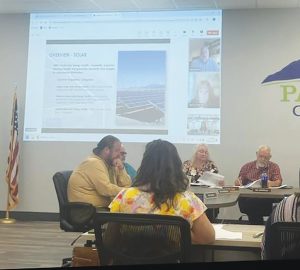
Zehner said it’s important for the county to have a singular application form for multiple types of review, “but I think another critical piece of that is the requirement for what an application needs to provide, what an applicant needs to provide.”
Orr Odom said generally the county needs to know who, why, when, where, and what the applicant is asking for, and ensure that information is concise and clear.
“If there are many different applications because there’s different information that’s necessary for a subdivision plat review, and that might be different than someone coming forward as we’re beginning to talk about solar and wanting to do it through the (15.2-) 2232 review,” she said.
Regarding the county’s current existing regulation and solar facility siting policy ordinance, Zehner said Berkley’s opinion is the current policy may not be as comprehensive as it needs to be to address local concerns and goals.
“I think that’s one of the points tonight – to hear what concerns you all have to ensure that policy does properly and comprehensively address your concerns,” he said, adding that the 15.2-2232 dictates the paramount documents for review for projects is the county’s comprehensive plan.
“One of the things we want to do is clarify the application requirements. Based on the 15.2-2232 review being an application type, what are the types of application documents that we can and should require for the review of these applications,” he said.
In terms of the county’s existing regulations, Zehner said Berkley would look to clarify the title of the county’s documents as the Comprehensive Plan serves as the county’s policy and the ordinance serves as the county’s ordinance.
“But because you lack zoning, and recognizing that the 15.2-2232 review is going to focus on the comprehensive plan, we want to make sure that any regulatory revisions that we would otherwise see in localities through zoning, that those be addressed in your policy. Because essentially, you can only really regulate these facilities through zoning as enabled by the state statutes, with the exception of that 2232 review that focuses on comp plan,” he said.
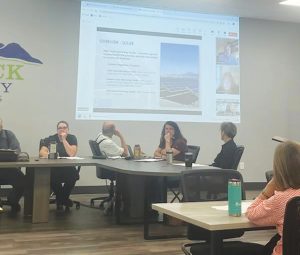 In terms of policy best practices, Zehner said the group encourages communities to evaluate the appropriateness of the land use and community support for these facilities.
In terms of policy best practices, Zehner said the group encourages communities to evaluate the appropriateness of the land use and community support for these facilities.
“I encourage you to look at the design, siting, and location of the size of the scale. Desired and expected economic development outcomes, acceptable and unacceptable outcomes to recreational, natural, cultural, and historical resources,” he said, adding the board should also examine the relationship between these uses and agricultural uses and areas suitable for agriculture and other community development goals.
Doug Perry, chairman, and of the Smith River District, said one of his concerns is pinpointing where the rights of property owners end and the county steps in.
“If we could define some of those then that would help us be less perception or opinionated and more, maybe we’re not going to clear cut a hundred acres of forest versus if that’s your property,” Perry said. “What defines where the rights begin and end between that property owners and the county. I’m not a fan of government coming in and saying this is what you have to do with your property.”
At the same time, Perry said if a person clear cuts a large acreage of land and pulls the stumps and roots out, and that changes the flow of water, which forces it into a stream that erodes the stream and affects properties downstream, “then is that outside of reason where the county can step in.”
Zehner said he believes every locality struggles with the same issue, and that is where flexibility is allowed, within reason, for property owners to see economic benefits from use of their property.
“But also balancing that with the rights of other property owners as well to enjoy their property and not be negatively impacted by how somebody else decides to use their property. So, it certainly is a fine line,” he said.
Jonathan Wood, of the Peter’s Creek District, said his concern about solar projects is the decommissioning after 40 years.
“I hope to live to see one of these decommissioned. Forty years is a long time, so we can say whatever we want, but the vast majority of us sitting at this table and in this room are not going to be here in 40 years to see if they hold up their end of the deal,” he said.
Wood said the information Berkley Group provided to the board and commission, about the pros and six to seven pages of cons, regarded solar energy.
“I think we really need to stop until we have time to figure it out. We don’t need to rush anything, I mean we’re talking about a 40-year mission. You don’t buy your house today that you’re going to pay for the next 30 years without thinking about it,” he said.
Wood said he favors a moratorium for a period of time until the county gets everything figured out.
“I think it will go a long way. I’m not saying that I would never, ever consider doing it, I’m just saying we need time to stop and think. We really do because there’s more information in this packet than we’ve seen in a long time. I would really like to have some time to think about it, talk to more people in our districts,” he said.
Clayton Kendrick, of the Mayo River District, said he hopes the board didn’t allow too much already by approving the Fairystone Solar project.
“I asked that engineer that night when we had the public hearing on it about the battery storage on the property. He said there wouldn’t be any. Well, I heard enough information to know that there’s got to be battery storage on them somewhere,” he said.
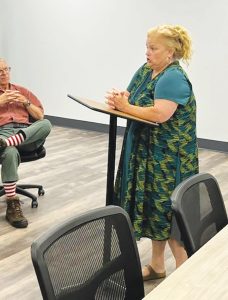
If the company building the solar farm isn’t going to have the battery storage, Kendrick said someone else is, and the board needs to know who.
Zehner said the county can address battery storage within the policy, and whether or not the county wants to allow that use or not.
“I do believe you can subject it to the same 2232 review as a public utility. There are some processes that because you don’t have zoning, that a utility can pursue in terms of seeking a certificate of public convenience and necessity to exempt themselves from local review,” he said.
Zehner also spoke about concerns regarding cadmium telluride in solar panels.
“In our research, relying on research that’s been done in academic institutions, we can’t find any basis to restrict the uses of panels that have any different types of chemical components or elemental components in them,” he said.
Zehner noted that Berkley is aware there are groups that object to the use of certain types of panels, and companies that predominantly use certain types of panels, like cadmium telluride panels.
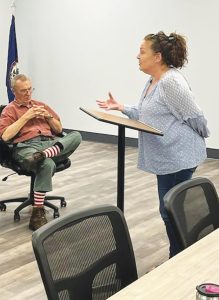
“Unfortunately, it seems like some of these objections may be more grounded in political objections to the background of certain companies and may be less about the actual composition and the risk for contamination,” he said.
Zehner said he believes the important thing to recognize is the chemical components and the elemental components of the solar panels are “cased in silicone and alloys that they don’t, by their nature, leach except if they’re subjected to certain damages and high heat that you would not commonly expect to see.”
In other matters, the commission:
*Approved the May meeting minutes.
*Appointed Sarah Wray to serve as the new vice-chairman.
*Heard from Trena Anderson.
*Heard from Valerie Loy.



